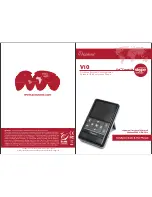
LGC-340/345W
4
LGIC
LG Information & Communications, Ltd.
FDMA allocates a unique frequencys to a channel. These channels are assigned on demand to users who request
service. During the period of the call, no other user can share the same frequency band. In FDD systems, the
users are assigned a channel as a pair of frequencies; one frequency is used for the forward channel, while the
other frequency is used for the reverse channel. This system is called FDD/FDMA system. Most of analog
cellular systems(AMPS, E-AMPS, NMT, ETACS, JTACS, etc. ) are FDD/FDMA system.
TDMA systems devide the radio spectrum into time slots, and each slot only one user is allowed to ether transmit
or receive. Each user occupies a cyclically repeating time slot, so a channel may be thought of as particular time
slot that reoccurs every frame, where N time slots comprise a frame. TDMA systems can apply in both TDD and
FDD.
Code Division Multiple Access (CDMA) is a radically new concept in wireless communications. It has gained
widespread international acceptance by cellular radio system operators as an upgrade that will dramatically
increase both their system capacity and the service quality. It has likewise been chosen for deployment by the
majority of the winners of the United States Personal Communications System spectrum auctions. It may seem,
however, mysterious for those who aren't familiar with it. This site is provided in an effort to dispel some of the
mystery and to disseminate at least a basic level of knowledge about the technology.
CDMA is a radically new concept in wireless communications. It has gained widespread international acceptance
by cellular radio system operators as an upgrade that will dramatically increase both their system capacity and the
service quality. It has likewise been chosen for deployment by the majority of the winners of the United States
Personal Communications System spectrum auctions. It may seem, however, mysterious for those who aren't
familiar with it. This site is provided in an effort to dispel some of the mystery and to disseminate at least a basic
level of knowledge about the technology.
CDMA is a form of spread-spectrum, a family of digital communication techniques that have been used in
military applications for many years. The core principle of spread spectrum is the use of noise-like carrier waves,
and, as the name implies, bandwidths much wider than that required for simple point-to-point communication at
the same data rate. Originally there were two motivations: either to resist enemy efforts to jam the
communications (anti-jam, or AJ), or to hide the fact that communication was even taking place, sometimes
called low probability of intercept (LPI). It has a history that goes back to the early days of World War II.
The use of CDMA for civilian mobile radio applications is novel. It was proposed theoretically in the late 1940's,
but the practical application in the civilian marketplace did not take place until 40 years later. Commercial
applications became possible because of two evolutionary developments. One was the availability of very low
cost, high density digital integrated circuits, which reduce the size, weight, and cost of the subscriber stations to
an acceptably low level. The other was the realization that optimal multiple access communication requires that
all user stations regulate their transmitter powers to the lowest that will achieve adequate signal quality.
CDMA changes the nature of the subscriber station from a predominately analog device to a predominately
digital device. Old-fashioned radio receivers separate stations or channels by filtering in the frequency domain.
CDMA receivers do not eliminate analog processing entirely, but they separate communication channels by
means of a pseudo-random modulation that is applied and removed in the digital domain, not on the basis of






































